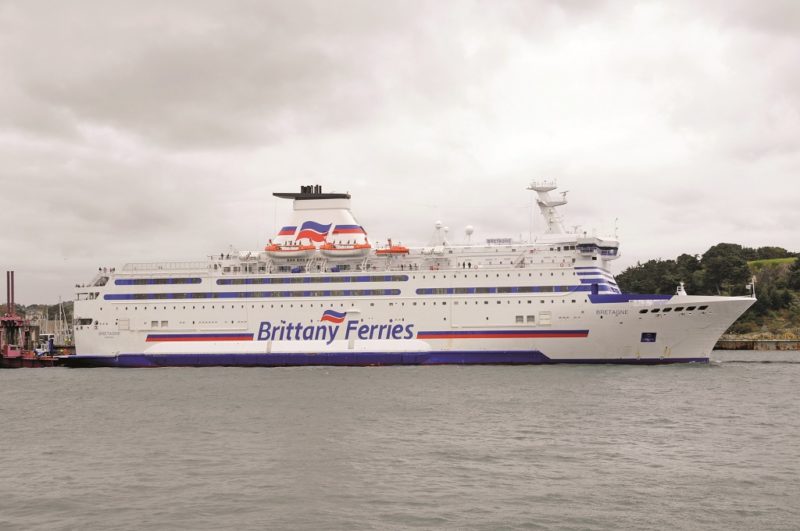
Saint-Malo is an historic French walled city with very good architecture and is a focus for all that occurs on the east side of the Brittany coast. The elegant walled town today overlooks the yacht marinas of the Bassin Vauban, which has not changed much over the centuries since the four locked ‘bassins’ of the inner harbour were built. It has, as with all of the harbours from Roscoff to Plumanach to Paimpol to Saint Brieuc, an exceptional rocky entrance channel and coastline. Masters of medium sized ferries of up to 160.0 metres in overall length, 30.0 metres moulded beam, and a loaded draft of 9.0 metres have an arduous task of avoiding precipitous rocks to port and starboard, some only twenty metres away.
The beautiful and elegant five storey terrace houses we see today in Saint-Malo have all been rebuilt in post-war years, as this historic town was destroyed in August 1944 by American forces led by the 3rd Army of General George Patton on 5th August 1944, but it took nearly one month of persistent shelling and dive bombing before the last German soldier surrendered on 2nd September 1944. The American 3rd Army under General Patton then took Brest, and swung eastwards to link up with the British battalions that had taken Caen in order to liberate Paris and drive eastwards in long tank columns into Germany. The heavily fortified Channel Islands of Jersey, Guernsey and particularly Alderney, were by passed by the American battalions as too difficult to attack, and were liberated by two British destroyers on the day after the war ended.
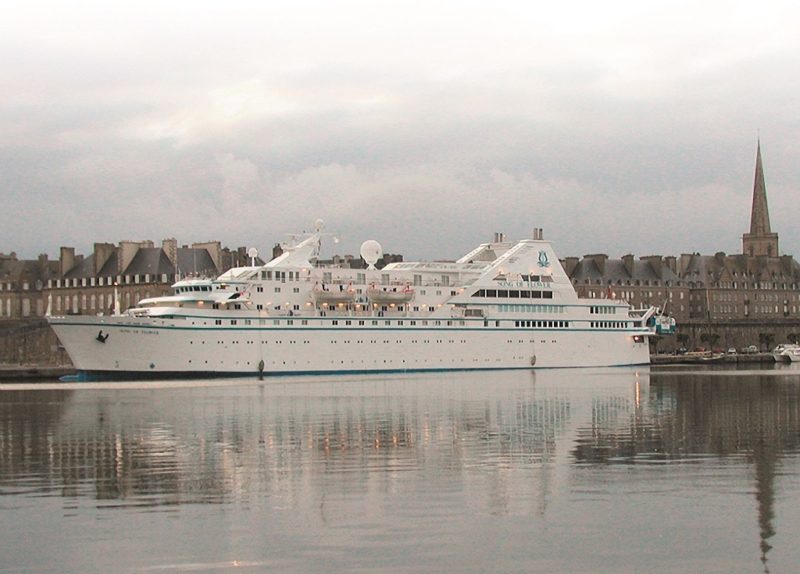
HISTORY OF SAINT-MALO
Saint-Malo was founded by the Gauls in the 1st century BC (Before Christ), an ancient town on the site of the Roman town of Reginca or Aletum. The fort at Aleth, in what is now Saint Servan, was built by Celtic tribesmen to guard the entrance to the Rance river. The Romans further fortified this site and departed in the 5th and 6th Century AD after the decline of the Roman Western European Empire, leaving the Gauls and a large Saxon Fort that was built on the shoreline to protect the town from seaborne raiders on the Rance Estuary. Many Celtic Britons from the western parts of Britain fled the instability of their homes and settled in Saint-Malo. The rocky island to the north of Aleth was connected to the mainland by a narrow causeway, and it was this natural defence that induced the population to move away from Aleth to what is now Saint-Malo during the period of brutal Viking raids.
The modern Saint-Malo traces its origins to a monastic settlement founded by Saint Brendan and Saint Aaron from Ireland in the early 6th century. The town also received many settlers from Wales including Saint Maclou, corrupted to the name of Saint-Malo. During the twenty years from 1395 to 1415, the city swore allegiance to King Charles VI of France, who granted the port free practice under the Duchy of Brittany. During the three years from 1590 to 1593, Saint Malo declared itself as the independent ‘Malouine Republic’, not French and not Breton, until King Henry IV of France agreed to become a catholic. Stone from the Iles de Chausey was increasingly used from the end of the 16th century to build the terraced houses of the city.
The Port of Saint-Malo was very busy and heavily used in the period from 1600 to 1800, with over three thousand arrivals and sailings and over 100,000 tons of trade per annum. At the end of the 17th century, the idea began to take place of transforming the Port of Saint-Malo into floating basins, in order to adapt the port to the bigger maritime activities of passengers, cargo, shipbuilding, and fishing. In 1884 and 1885, two basins were opened, and in 1931 the large Naye lock was built, closing the port and creating four basins. The Port of Saint-Malo was then equipped with cranes, locks, quays, docking areas and storage areas, and was one of the leading nine Breton ports. The port was full of three masted sailing ships and steamers during World War I, which revealed shortcomings in the equipment of the port, and a modernisation programme was begun in the 1930s despite the worldwide freight Depression. Small steam powered ferries ran across the harbour, as well as a tall wheeled and raised contraption with a covered verandah cabin on top that transported passengers across the harbour. Trams used to run through Saint-Malo town and stop outside the colossal stone main gate of Intra Muros and the famous Hotel Pomme d’Or (Golden Apple).
The Cathedral of Saint-Malo is in the centre of a tight cluster of sixteen hectares that were burned down in for the first time in 1661. Architects Vauban and Garangeau rehabilitated it and extended it to 24 hectares and forms the present day city. The Cathedral of Saint Vincent, whose construction began in the 12th century, includes an Anjou style nave and the cloister, which is the oldest part of the Cathedral. The magnificent Gothic style choir with an Anglo-Norman style flat chevet were also built in the middle of the 12th century. The Grand Donjon and Petit Donjon were built as horseshoe fortresses with four huge angle towers and walls of two to three metre thickness. This style of heavy bastion impregnability is also seen in the tall Solidor Castle Tower in Saint Servan, with an entrance bastion and three towers, and was continued by the architect Vauban in the late 17th century. Three forts were built on offshore islands as Fort National, Fort du Petit Be and Fort de la Conchee by architect Garangeau to also make the approaches to the port impregnable. The magnificent mansions of the shipowners near Port de Dinan and Porte Saint Vincent were built in the 17th century.
However, the harbour takes the full brunt of Channel storms with strong under currents, and the most hazardous of precipitous rocks that one can find anywhere in the world. As a consequence of this dramatic coastline, the reefs and rocks have one of the largest underwater graveyards in the world. The significant port trade led to a growth in the local population (known as Malouines) from 10,730 in 1793, to 12,316 in 1872, and 13,686 in 1936. The current population of 46,100 has declined slightly from 50,675 in 1999. Sailing ships from Le Havre and from Granville on the west side of the Cotentin peninsula, often traded or repaired in the harbour of Saint-Malo. Thus, the jagged reefs and rocks, hold the remains of hundreds of wrecked ships, two of which were discovered in 1995 on the famous Natiere reef off the coast of Saint-Malo, and dating to the first part of the 18th century. Their discovery and later underwater excavation has given much insight into Saint-Malo and her shipbuilding history in the 18th century.
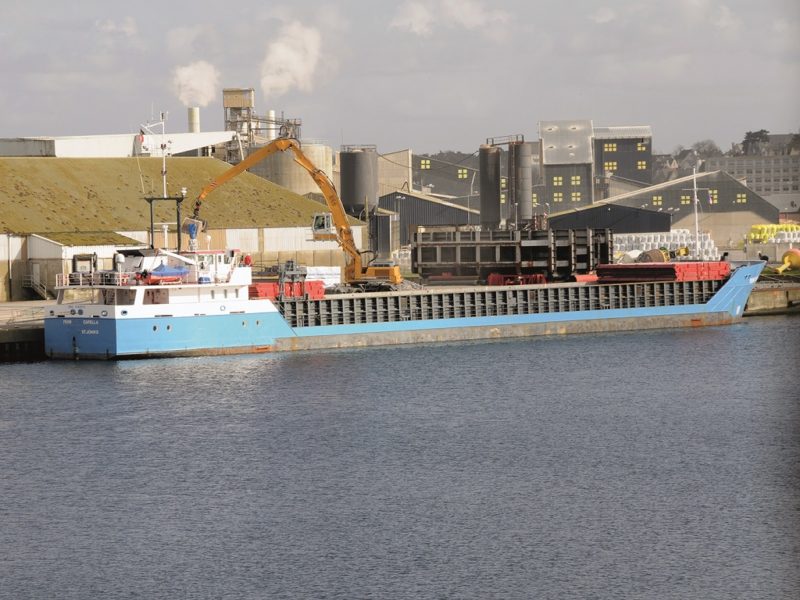
La Dauphine was built in the winter of 1702/03 and fitted out as a frigate of 300 tons displacement, but sank after hitting the rocks under the command of Capt. Michel Dubocage. The excavations uncovered 31 metres of the starboard side of the vessel from the aft deck to the gun deck. As a commercial raiding privateer, she had been given to local private merchants by Louis XIV for commerce raiding against the enemies of the French State. She was escorting a captured British ship, Dragon, when she sank at the entrance to Saint-Malo harbour on 11th December 1704. She had raided from Transatlantic to Mediterranean waters, as the crockery finds in her hull revealed, together with the recovered cannons and pistols. The personal items of her crew also revealed who and where they originated from. Capt. Michel Dubocage had joined the French Navy at the age of sixteen years, and rose to the ranks of Lieutenant and Master by 1694. He was a successful commercial pirate raider, and was cleared of incompetence after the sinking, and went on to have a long naval career including expeditions to the French possessions in the Pacific, and he died in 1727 as a wealthy man living in Le Havre.
L’ Aimable Grenot was another privateer bound for Cadiz in Spain to ply the Mediterranean trades at the time of her sinking around 1760. A length of 36 metres of her wooden hull on the starboard side from her keel to the second deck was excavated, and dated by the dendrochronology of her wooden beams to have been built in 1746/47 at Granville as a frigate of 400 tons displacement. She had two Masters in succession in Pierre de la Houssaye and Joseph Francois Hugon, who both had daring reputations as commercial raiders and pirates. The hull had used cast iron ingots as ballast and these were stamped with the 1746 marks of two Baltimore iron foundries that supplied ballast for British ships, and which were then captured by French privateers. The frigate was wrecked while on a voyage from Granville to Saint-Malo.
The walled city thus had a long history of piracy, earning much wealth from extortion and overseas adventures. As early as the 13th century, the Malouins were very successful in the capture and extortion of money from British ships. The privateers of Saint-Malo forced English vessels in the Channel to pay ‘tribute’ money or be sunk. The area of the town and its immediate environs is 14.1 square miles, and has a big summer tourist trade with a record high temperature of 39.4 degrees Centigrade and an average low temperature of 8.0 degrees Centigrade in winter. Saint-Malo is twinned with Port Louis in Mauritius, Gaspe and Saint-Malo in Quebec (Canada) and Cowes on the Isle of Wight. The famous discoverer Jacques Cartier lived in and sailed from Saint-Malo to the St. Lawrence River, and visited the villages of Native Americans at Stadacona and Hochelaga that would later become the present day cities of Quebec and Montreal. The famous discoverer Bougainville sailed from Saint-Malo to found the first settlement on the Falkland Islands, naming them as Iles Malouines, which became corrupted into the Spanish name of Islas Malvinas, with a claim of belonging to Spanish speaking Argentina instead of their very British ownership.
The French steamer Saint Thomas loaded apples at Saint-Malo for Algeria and Tunisia in 1912, with other cargoes such as coal, phosphates, timber, grain, fruit, butter, cattle and ‘les choux-fleurs’ (cauliflowers) arriving or leaving for these French colonies. Regular ferries now run to the Channel Islands and the South Coast of England with Britanny Ferries and Condor Ferries. The Coat of Arms of this historic town is a red shield featuring a yellow portcullis upon which a white animal is resting, and the town has both a Maritime Academy and an Institute of Higher Technology.
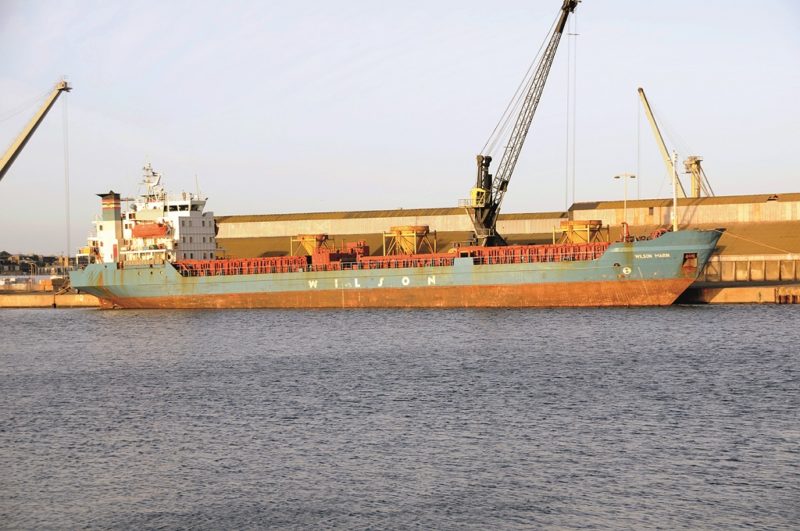
THE BATTLE OF SAINT-MALO
During World War II, the historic town of Saint-Malo was almost totally destroyed in August and September 1944 by fires lit by German troops and constant shelling and dive bombing of the Allies. The beaches of the resort of Dinard, opposite Saint-Malo across the Rance estuary, had been heavily fortified against possible Allied commando raids. The town was fortified by long range howitzers and artillery and the fortification complex was occupied by 12,000 German troops. Colonel Andreas von Aulock, the German commander, refused to surrender when asked to do so by the town authorities to avoid bloodshed, proclaiming ‘He would defend Saint-Malo to the last man, even if that was himself’.
The first American attack was on 5th August 1944 by the 83rd Infantry Division of the 3rd Army and German positions at Chateauneuf quickly fell. Cancale fishing port was abandoned and occupied by the Americans on the following day, and also Dinan fell to Free French forces on the same day. On 7th August, the Germans blew up the docks and locks in addition to having heavily mined the harbour and sunk one hundred fishing boats. The German troops shortened their lines and drew closer to the ancient citadel of St. Servan-sur-Mer, reinforced with concrete gun emplacements. Heavily effective artillery positions on the island of Cezembre in the approaches to the harbour of Saint-Malo were out of range of American artillery, and the battle raged on with small craft from the German garrisons on Jersey, Guernsey and Alderney bringing in water and removing injured men from the battlefield.
On 13th August 1944, all of the walled city of Saint-Malo was on fire, and a truce was arranged to allow French civilians to flee the city. American infantry attacks took the outlying German positions at St. Ideuc and La Varde, the latter surrendering under constant artillery bombardment and dive bombing in the late evening of 17th August. Cezembre surrendered on 2nd September when the garrison of 300 German troops ran out of water, with a total of 10,000 German prisoners of war or dead during the battle that lasted over two weeks.
Saint-Malo was completely devastated with around 90% of the buildings destroyed, and was rebuilt during the post-war period from 1948 to 1960 in the same French style of tall terraced houses within the walled town. It was decided to rebuild as closely as possible to how it had been before, and the walls and ramparts were rebuilt exactly as they were under the auspices of the French Directorate of Historical Monuments. The granite city had been burned down by the Germans, and the only half timbered constructions that remain are the inner courtyard of the birth place house of Chateaubriand, timber panelled houses in Rue du Pelicot, and the archway over Rue des Vieux Ramparts. The restored Cathedral was adorned with new outstanding stained glass windows, and the spire was replaced with a steeper and higher one. The Town Hall (Hotel de Ville) now has the Saint-Malo Museum, where collections of illustrious Malouin memorabilia are preserved along with the artefacts of the past activities of a great seafaring port.
The three masted German sailing ship Gorck Fock and the French topsail schooners Etoile and Belle Poule visited Saint-Malo in 1961, and all of the trio locked into the Bassin Vauban for an extended stay. Gorck Fock was built in 1958 in Germany and a sister of the first ship of that name built in 1933, both ships named in honour of the German writer Johann Kinau, who wrote under the pseudonym of Gorch Fock, and who died in the Battle of Jutland in 1916. Since her completion in 1958, she has undertaken 146 cruises including a long world tour in 1988, and is under the command of the German Naval Academy at Flensburg-Murwik. Etoile and Belle Poule are identical topsail schooners built in 1932 by Chantiers Naval de Normandie at Fecamp for the French Naval Academy (Ecole Navale). Their design harks back to the ‘Pampolaise’ type of fishing schooners that sailed from the ports of Brittany including Saint-Malo to Iceland in the late 1800s. They feature a displacement tonnage of 300 tons, overall length of 123.0 feet, moulded beam of 24.0 feet, and mean draft of 12.0 feet, sail area of 500m2, auxiliary diesels of 285 horse power for entering and leaving port, together with a crew of 16 and a dozen trainees.
Saint-Malo is now a sub-prefecture of Ille-et-Vilaine, and became the commune of Saint-Malo in 1967 when Saint Servan merged with Parame and Dinard. Saint-Malo was the site of an Anglo-French summit meeting in 1968 that led to significant progress regarding European Defence Policy.

LIGHTHOUSES and LIGHT TOWERS of the AREA
There are over twenty tall lighthouses or light towers, some with black and white stripes, to guard the very hazardous rock strewn coastline of the area from Cap de la Hague on the Cotentin Peninsula to the Ushant area, as well as the areas around the Channel Islands of Alderney, Guernsey and Jersey. They are absolutely essential to navigation in this area, which test experienced navigators to their utmost ability, with many only making or recommending approaches to certain reefs during daytime e.g. the extensive area of hazardous reefs known as Les Minquiers, lying directly on the main ferry route from St. Helier on Jersey to Saint-Malo. These twenty very tall lighthouses and light towers are:-
- La Platte on the Cap de la Hague area
- Gros du Raz on the Cap de la Hague area
- Quenard Point black and white lighthouse on Alderney
- Platte Fougere black and white lighthouse on Guernsey
- La Corbiere on the south west corner of Jersey
- Noirmont Point black and white light house on the approach to St. Helier on Jersey
- Maitre Ile on Les Ecrehou to north east of Jersey
- Tower Light on Les Minquiers
- Grande Ile on Iles Chausey to north east of Saint-Malo
- Le Grand Jardin lighthouse off Saint-Malo
- Ile Harbour on the Baie de St. Brieuc / L’ Ost Pic on an island near Paimpol
- Les Roches Douvres on rocks twenty miles north of L’ Ost Pic
- Les Heaux near Ile de Brehat
- Ile de Batz at Roscoff
- Ile Vierge at L’ Abervrach
- Le Four at Portsall
- Le Stiff on Ushant
- Creach black and white lighthouse on Ushant
- Kereon lighthouse on Ile de Molene near Ushant
- Pointe de St. Matthieu near Le Conquet on the mainland opposite Ushant
The approach and entry channels to Saint-Malo are six in number, with the main pair being to the west of Ile de Cezembre in the Channel de la Grande Porte and the Channel de la Petite Porte. They can both be used by day or by night and in most weathers, and pass the tall grey lighthouse with a red top of Le Grand Jardin. The Channel de la Grande Porte is slightly easier going in strong offshore winds. The secondary Channel du Decolle leads close inshore from the west, but is only really suitable for leaving Saint-Malo near high water.
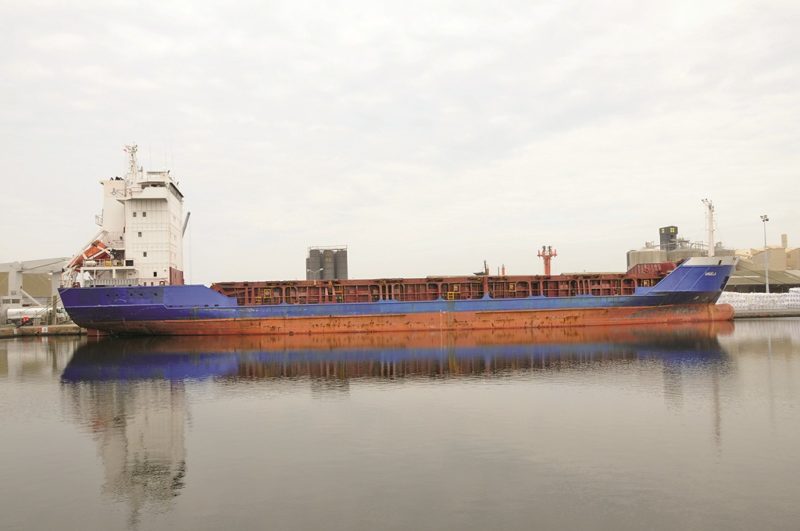
There are three approach channels from the east of Ile de Cezembre in the Channel de la Grande Conchee, Channel des Petits Pointus and Channel de la Bigne. They can only be used by day and with sufficient rise of the tide over the shallow area between Ile de Cezembre and Saint-Malo. The Channel des Petits Pointus is the most useful of these if you are arriving from the east from Granville, Cancale or Chausey.
There are numerous drying and above water hazardous rocks in the outer Rance estuary, but they are all well marked and fall into line ahead on entry. The strong cross tides provide the main hazard, especially if you are approaching the Channel de la Petite Porte around mid flood of tide. The tides are a powerful four knots at springs across the outer part of the Channel de la Petite Porte, but decrease significantly once past Le Grand Jardin lighthouse.
The shipping port of Saint-Malo is divided into four basins with a total quay length of 4,500 metres. The main Naye cruise passenger and car ferry terminal is just to the south of the main Naye lock, with dimensions of 160.0 metres by 25.0 metres that give access for ships of up to 5,000 dwt to the four basins of the port. These are:-
Bassin Vauban of length 1,100 metres, alongside depths of seven to ten metres with a yacht marina to the north of the basin, and coastal cargo berths on the east and west sides of the basin. A lock at the north end leads to the next basin of Bassin Duguay Trouin.
Bassin Duguay Trouin of length 1,870 metres with alongside depths of 5.8 to 7.3 metres with several coastal cargo berths for ships of up to 120.0 metres in length, 16.5 metres beam, and 5.5 metres draft.
Bassin Bouvet which is entered from the south end of Bassin Vauban through a lock of width 17.5 metres and depth of 6.7 metres. Several coastal cargo berths with alongside depths of 5.3 to 6.3 metres and a slipway.
Bassin Jacques Cartier, previously known as Mare aux Canards (Ducks), and entered by two narrow width locks from Bassin Vauban and Bassin Bouvet.
Naye Ferry and Cruise Terminal with two berths on the outside of the main Naye lock.
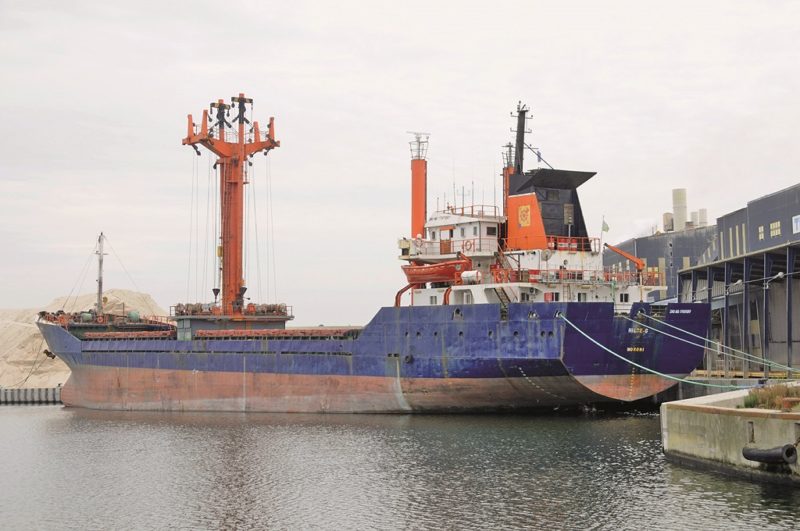
CORSAIRS or SEAFARING ROBBERS
The pirates of Saint-Malo once roved the English Channel and the Bay of Biscay taking whatever they wanted from merchant ships unfortunate enough to encounter them. These rich, swashbuckling robbers then went home to huge country estates to live the life of genteel country gentlemen. They were called corsairs as their swift, silent sailing ships with ruthless crews appeared on the horizon and swiftly closed their targets to rob and pillage and extract ‘tribute’ money. They then stole away home to their safe and secret hideaways at Saint-Malo. The tens of thousands of British, German and Dutch tourists that today arrive in ferries and cruise ships probably do not realise this, as this pretty ferry port and gateway to Brittany does not appear to have such a violent past. A very large part of the prosperity of Saint-Malo is owed to these fierce and fearless corsairs, and the more lawful merchant seafarers of the port sailed around the world to every one of the continents.
There are sixty country houses and estates built by these ruthless corsairs around Saint-Malo, and are known as Malouinieres, and all are within seven and a half miles of the walled city. One of the most classic of these can be visited today at La Ville-Bague, which dates from 1715. It has the classic architecture of a small French country house, with fourteen windows on each of the two floors of the main façade, with stone treated by white sand blasting, and the windows are detailed with brown stone surrounds. The steeply arched and pitched roof contains five more windows and bedrooms. Six chimneys protrude from the roof to tell one that the house was kept warm, and gardeners tended the enormous clipped lawns to the front.

La Ville-Bague has been restored from a ruin by the family of Madame Chauveau and is a truly great treasure and is registered as a French National Monument. In the main Grand Salon is an 18th century mural by Pissaro among the many artefacts built for the house and removed in 1820 and then rediscovered in an antique auction. A massive dresser in another room is filled with beautiful porcelain and china. The guided tour of the house lasts an hour and a half and includes the interiors of the malouiniere, the gardens, the dovecote, and the beautiful stone 16th century chapel of Saint Sophia with a large rose window above the entrance door. The chapel predates the house by around two centuries, and the tours of the chateau are twice daily at 1430 hours and 1600 hours until 30th September and then once a day at 1500 hours until the chateau is closed for the winter at the end of October. Visitors are greeted by an actor playing the part of Long John Silver, complete with blue longcoat, red breeches, green hat, a telescope and a parrot. This strange sight is explained away by Madame Chauveau as she spent her teenage years in the East Midlands of England and read widely the works of Robert Louis Stevenson and Treasure Island in particular, written in 1883. The gaily pained small ferries that run across the harbour from Saint-Malo to the resort of Dinard are owned by La Compagnie du Corsaires.
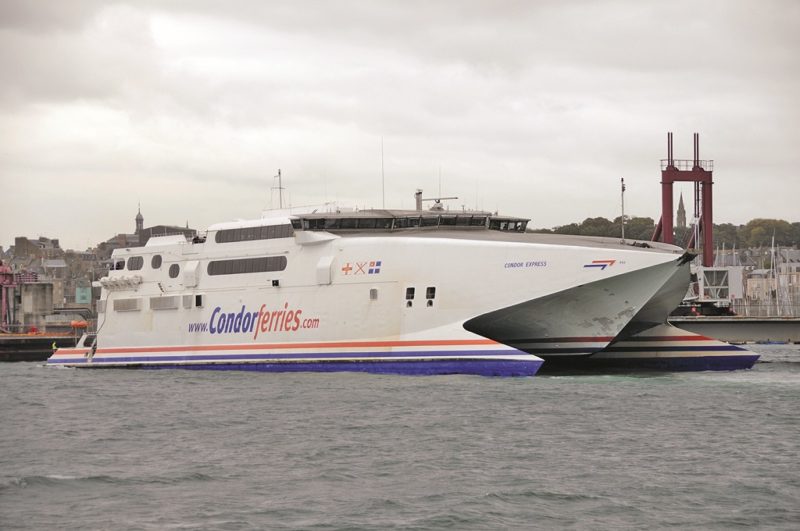
THE MODERN PORT OF SAINT-MALO
Yellow funnelled paddle and screw propelled passenger steamers ran from Jersey to Saint-Malo in Victorian and Edwardian times. The traditional twin screw Southern Railways ferry Britanny of 1,400 grt and built in 1933 by Denny of Dumbarton with accommodation for 850 passengers and powered by four steam turbines with dimensions of overall length 260.0 feet, moulded beam of 39.0 feet and moulded depth of 14.0 feet also ran from Jersey to Saint-Malo. She was replaced in 1965 by the regular daily fast craft sailings of Condor Ferries. and Brittany Ferries later introduced a regular passenger and cargo service to Poole in 1976. The current and impressive Brittany Ferries ro-pax vessel on the route from Portsmouth to Saint-Malo is Bretagne, built in 1989 by Chantiers de l’Atlantique at Saint Nazaire with accommodation for 1,980 passengers, 1,146 berthed and the remainder on aircraft style seats, 580 cars or the equivalent number of trucks on her car deck, and a crew of 130.
Brittany Ferries in July 2021 ordered a pair of LNG and electric hybrid powered Ro-Paxes to replace two of their oldest ferries in the fleet. The new ferries are based on the Stena Line E-Flexer design concept as with their chartered Galicia from Stena Line and the on order Salamanca and Santona. This new pair will replace Bretagne of 1989 on the Portsmouth to Saint-Malo route, and Normandie on the Portsmouth to Caen (Ouistrehamn) route.
Saint-Malo thus quickly became the main passenger port of Brittany, and today also has a good number of cruise ships calling. The port is equipped for the fast unloading of molasses, used in agricultural nutrition, and also of phosphoric acid, these two commodities totalling 400,000 tonnes each year. In 1995, the trade throughput of imports and exports exceeded 2.0 million tonnes, with the port then the third largest cargo port of Brittany after Lorient and Brest.
A new fishing harbour was created in 1965, and the Bassin Bouvet was then equipped with new facilities for trawler owners, fishmongers and fishermen. The smaller fish auction hall at the nearby fishing port of Cancale was rebuilt in 1994. Saint-Malo trawlers fish for cod and blue whiting in the Western Channel, as their traditional deep sea Grand Banks grounds off Newfoundland were denied to them in 1980 by the Federal Government of Canada. Wooden small boat construction is carried on by the Duguay-Trouin and Jacques Cartier yards of pleasure boats, ferry boats, service boats and fishing boats.
The Port Traffic in 2019 was as follows. Figures since then are not relevant as they are distorted by Covid:-
PASSENGER
Ferries to and from the U.K. 321,129
To and from the Channel Islands 428,173
French coastal ferries 316,775
Cruise ship passengers 45,427
Total of passengers 1,111,504
The Port of Saint-Malo thus has a passenger traffic of 750,000 passengers to the U.K. and the Channel Islands, and also is the leader in cruising of all of the Breton ports It has hosted between 21 and 43 cruise ships each year during the years from 2016 to 2020, some ships having two night stopovers. Four cruise ships can be accommodated at any one time, with two at the Naye Ferry and Cruise Terminal, and two more at other docks. Some 55% of passengers are American, 30% are German, and 10% are British, with all taking shore excursions to the delights of Saint-Malo e.g. walking the extensive ramparts to the classic Intra Muros walled gate, restaurants such as La Duchesse Anne, the Place Chateaubriand bistros, Creperie la Corps de Garde, Restaurant de la Porte St. Pierre and Hotel de France and many others, as well as the surrounding towns and country e.g. Mont Saint Michel, La Ville-Bague etc.
Cruise lines calling at Saint-Malo include frequent calls by Compagnie des Iles du Ponant Cruises, as well as AIDA Cruises, Saga Cruises, Azamara Cruises, Regent Seven Seas Cruises, Oceania Cruises, Silversea Cruises, Seabourn Cruises, Windstar Cruises, Crystal Cruises, Peter Deilmann Cruises, Hanseatic Cruises, Hapag Lloyd Cruises, Hapag Lloyd Expedition Cruises, Phoenix SeeReisen, Plantours Cruises, Mystic Cruises, Scenic Cruises, Sea Cloud Cruises as well as the local Corsaire River Cruises.
The first cruise ship in 1990 of the French Compagnie des Iles du Ponant was the classic, streamlined, white hulled Le Ponant of 1,490 grt, which hoisted five big triangular sails of 1,300m2 on three masts for cruising. She had been built at Villeneuve-la-Garenne in France and had dimensions of overall length of 290.7 feet, moulded beam of 39.4 feet, and moulded depth of 23.1 feet, and a draft of 13.1 feet. She had a cruising speed under sail of 14 knots, and under her Deutz high speed four stroke diesel engines a cruising speed of 15 knots was obtained.
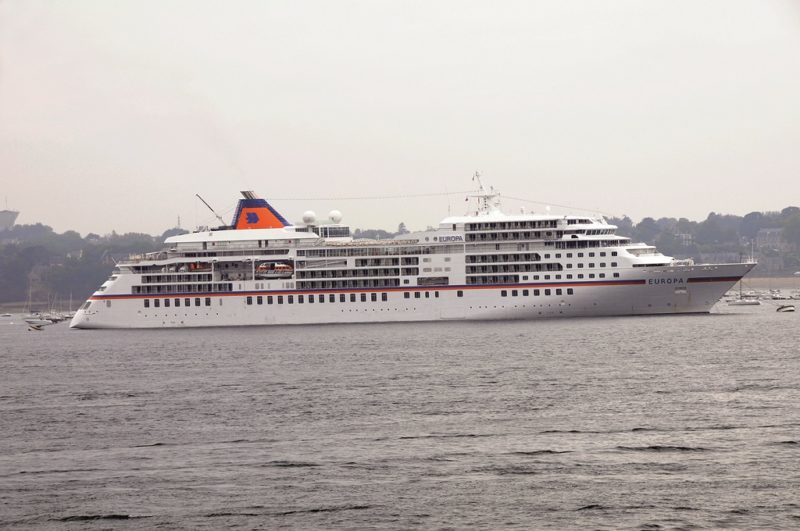
CARGO
Total cargo of imports and exports in 2019 of 1.290 million tonnes of which 902,032 tonnes were carried by cargo ships of up to 5,000 dwt, and the remaining tonnage was carried by the large passenger ferries on their car and truck decks. Vertical cargo lifting between ships and quays uses harbour cranes of up to 12 tonnes capacity. Horizontal cargo work includes moving, storing and processing of cargo by dock workers on the quayside, and the onward movement of cargo by truck or train. The Bassin Vauban for both cargo ships and yachts is worked for 2.5 hours each side of High Water. There are five inward lockings (Entrees) and five outward lockings (Sorties), each timed to open at half hour intervals. Bassin Duguay Trouin has grain silos and a bonded wine tank warehouse, with bonded warehouses also for other commodities. Two tugs are available for ship handling, and pilots are onboard all ships on port entry and exit and for the shifting of berths. The presence of a pilot at all times is mandatory and absolutely essential given the rocky nature of the approach channels. The cargo ship Wilson Limerick of Wilson Line of 3,812 dwt and built in 2012, the German cargo ship Allertal of 2,910 dwt and built in 2005, and the Russian cargo ship Kapitan Sakharov of 3,483 dwt and built in 2004, were working cargo in the Port of Saint-Malo on 1st November 2021.
FISH
Saint-Malo fish hall landed 1,193.2 tonnes of fish, and the smaller fish hall at Cancale landed 120.0 tonnes of fish and shellfish in 2019. The fish selling halls in Saint-Malo sell white fish, cuttlefish, spider crabs, bulot, scallop shells and other species, and are of 1,350m2, and there is one smaller fish selling hall at Cancale.
There are three cold storage fish rooms at Saint-Malo, including one of 200m2. There is ice production of two tonnes per day at Saint-Malo.
YACHT MARINAS
Saint-Malo has two marinas for yachts, the first at the north end of the Bassin Vauban under the walls of the walled city, a stone’s throw away from the Porte Saint-Vicent and the Tourist Office.
It offers 196 yacht moorings, seats, water and electricity terminals, two walkways, plenty of showers and toilets accessible day and night, internet connection, washing machines and heat dryers.
Port des Sablons marina in Saint Servan nestles at the foot of the City of Alet, with a twenty minute walk to the Intra Muros walled gate entrance to the old city of Saint-Malo. There are plenty of yacht berths here with the same facilities as Bassin Vauban.
PORT OPERATOR
The operating concession of the Port of Saint-Malo was entrusted by the State to the Chamber of Commerce and Industry of Saint-Malo in 1957 and was concluded for an initial period of 20 years. It was then extended for a further forty years in 1977 until the end of 2019.
On 1st January 2020 and for a period of ten years, management of the port and other Brittany ports has been entrusted to the firm of EDEIS, which is a major player in the engineering and building of new buildings, and a leader in French airport concessions. EDEIS employs 900 people in its engineering division and concessions divisions.
There are two possible anchorages between Saint-Malo and the Rance barrage, the first off Saint Servan in Solidor Bay on the east side, and the second off the Anse de Dinard on the west side.
Navigation in the channels gives multiple choices for possible yacht anchoring in good weather e.g. off the archipelago of Ebihens, the Ile de Cezembre, the Grand Be at the front of the ramparts at high tide, and near Fort National or the other forts, or Rotheneuf Harbour, or near Besnard Island.
There are good road, motorway and rail links to and from the port, as well as a nearby international airport. Business and retail parks are nearby for the development of modern technologies e.g. medical, cosmetic, nutritional and tidal energy sources. These new industries generate further cargo business for the port, in addition to the traditional import cargoes of molasses for soil nutrition, acids, timber, animal feed, minerals and other types of cargoes.
The Naye Ferry and Cruise Terminal is to undergo an expensive €110 million updating project, starting in the fourth quarter of 2022 and lasting until at least the first quarter of 2025.
Work will include deepening the alongside draft for bigger ferries and cruise ships, modernising the passenger transit and customs clearance, and replacing out of date areas with modern functionality areas to improve the through capacity of the terminal. Work studies for developing these improvements were completed in the years of 2020 and 2021.
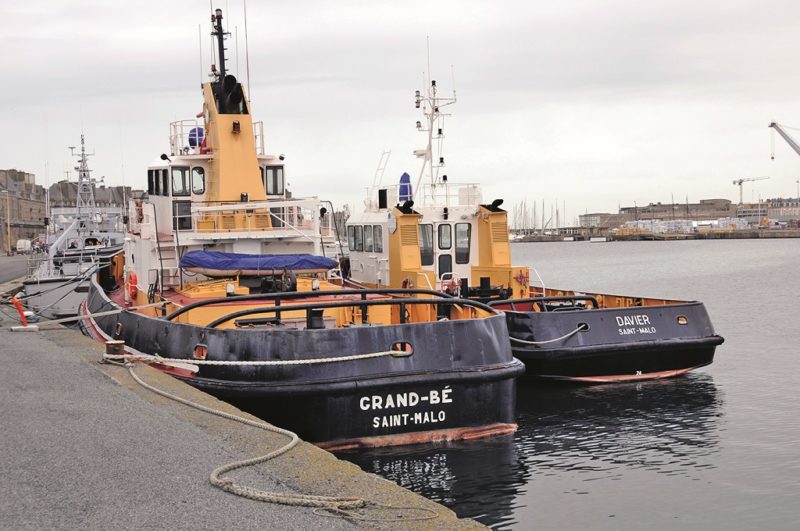
POSTSCRIPT
The black and yellow hulled French frigate Etoile du Roy is a twin masted 47.0 metre in length replica of a French frigate that is permanently moored in the Bassin Duguay-Trouin as a floating museum and tourist attraction. She can hoist 790m2 of sail, has twenty cannon, and a Turkish figurehead. A large crew manned this type of French sailing frigate on expeditions to French colonies around the world.
The black and white hulled two masted French brigantine La Malouine is registered in Saint-Malo, and was built in 1968 in Gdansk in Poland as a small Baltic trader, and was converted to a brigantine in 1992 named Willem using the drawings of Dutch designer Olivier van Meer.
She sailed in the charter market with sailing guests mainly in the Baltic in match races, team training, incentives, and in the participation of many sailing events at Rostock, Kiel, Hamburg, Rouen, Brest and Amsterdam.
She was sold in 2010 to Francois Bertrand and registered at Saint-Malo as La Malouine, meaning a woman from Saint-Malo. She was then sold in 2016 to Capt. Roy Kerr of the Port of Dumfries in South West Scotland and has participated in Tall Ships Races in the North Sea, using the Caledonian Canal for transit.
She hoisted seven big sails when she sailed from Dockfoot wharf at Dumfries down the River Nith, but today is laid up at the old granite exporting port of Palnackie on the nearby River Urr to the west of Dumfries. I have been onboard this classic vessel, in appearance she is a smaller version of the classic black and white hulled brigantine Royalist.
The Port of Saint-Malo has a very long history of over two thousand years, and will continue to prosper in the future as both a major ferry and cruise passenger and yacht centre, and also as a small traditional cargo port working various types of bulk cargo for local imports and exports.

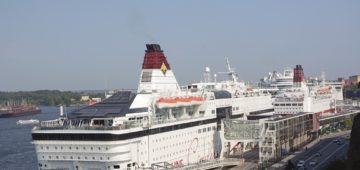



Comments
Sorry, comments are closed for this item